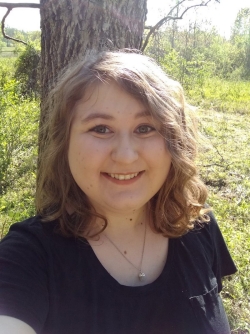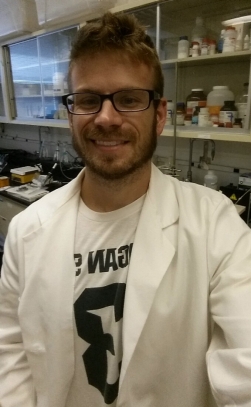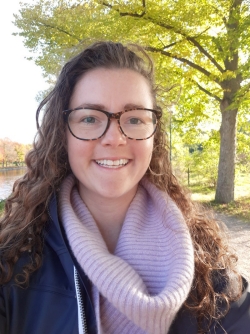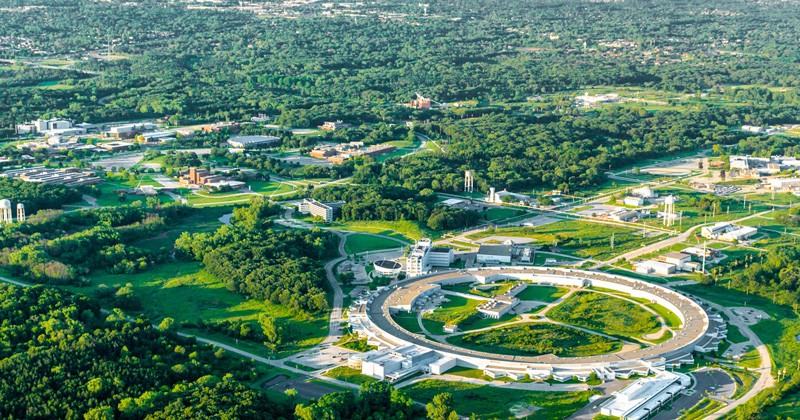Grants enable grad students to explore energy challenges at U.S. National Labs
During the fall of 2020, Carly Byron and Jeffrey Hudson, both doctoral students at the University of Delaware, will have the opportunity to work with some of modern science’s most advanced tools, courtesy of the U.S. Department of Energy’s National Laboratories.
The two are among 62 graduate students from 50 universities nationwide who were selected to receive competitive grants from the DOE Office of Science Graduate Student Research Program. The awards support the students’ travel and up to $3,000 per month in living expenses while in residence at a National Lab, a period that may range from three to 12 months.
Byron, a doctoral student from Rochester, New York, wants to capture greenhouse gases and convert them into renewable fuels. At Argonne National Laboratory near Chicago, she is looking forward to using a synchrotron called the Advanced Photon Source — a particle accelerator the size of a football field that works like a giant microscope.

UD doctoral student Carly Byron wants to capture greenhouse gases and convert them into renewable fuels. She will pursue research at Argonne National Laboratory near Chicago.
When an electron inside this synchrotron is accelerated to almost the speed of light and forced to switch directions using magnetic fields, the electron emits an X-ray. This blazing light is beamed to laboratory workstations for illuminating the chemistry and structure of a material, atom by atom, in 3D.
“I’m very excited to win the DOE grant,” said Byron, whose doctoral adviser is Prof. Andrew Teplyakov in UD’s Department of Chemistry and Biochemistry. “It will enable me to further characterize the catalysts I’m studying. I’m very grateful for this opportunity, given that there are less than 20 synchrotron facilities in the U.S.”
Byron’s research focuses on hydrocarbon-reforming chemical reactions, which have numerous applications in the renewable energy field. She is examining highly active metal catalysts to find the best chemical spurs that will speed up the dry reforming of methane, which converts carbon dioxide and methane into synthesis gas. This syngas can then be further processed into renewable fuels.
“This research is important in addressing the growing energy and environmental crisis, especially if we can capture greenhouse gases and transform them into a source of fuel on a wide scale,” Byron said. “Ideally, I hope it will lead to a reduction in the effects of global warming and a reliable source of energy.”
National Energy and Technology Laboratory
Doctoral student Jeffrey Hudson, from Marysville, Michigan, is heading to the National Energy and Technology Laboratory (NETL), located just outside Pittsburgh, Pennsylvania. He is taking a deeper look at the chemical interactions between iron and shale organic matter, with the goal to optimize oil and natural gas production from fracking wells. Hudson’s doctoral adviser is Prof. Yu-Ping Chin in UD’s Department of Civil and Environmental Engineering.

Jeffrey Hudson is heading to the National Energy and Technology Laboratory (NETL), just outside Pittsburgh, to expand his doctoral research focusing on optimizing oil and natural gas production from fracking wells.
“Winning this grant is an honor. I mean, how many people get to say they have a fellowship with the Department of Energy Office of Science?” Hudson said. “It will enable me to continue applying some of my analytical skills and knowledge to a new area of focus while also learning new lab skills.”
Hudson previously examined the reactivity of iron and how it can be a reducing agent for certain environmental contaminants. Binding molecules called organic ligands can act as catalysts to accelerate the iron’s reactivity and destroy pollutants more quickly. In his new study, he’s probing the transformation of iron to iron oxide because a buildup of iron oxide can block the tiny cracks and fissures where drillers are trying to get to natural gas.
“Interestingly, it appears that organic matter from the shale present in the rock formations catalyzes this process,” Hudson said. “Hopefully, the work I do will lead to a better understanding of the geochemistry far below the surface and will enable engineers to implement better chemical strategies to maintain high production rates in fracking wells.”
Hudson and Byron continue UD’s track record for winning these highly competitive grants. Last year, Margaret (Maggie) Capooci and Aeri Gosselin won funding and recently completed their fellowships.
Lawrence Livermore National Lab
Capooci, from Jessup, Pennsylvania, is now completing her doctorate in the Water Science and Policy Program, working with adviser Prof. Rodrigo Vargas. She wants to expand understanding of the patterns and processes governing greenhouse gas emissions from tidal marsh soils.

For her doctoral research, Maggie Capooci worked at the Lawrence Livermore National Laboratory in California to examine the age of the carbon being released from the marsh at Delaware’s St. Jones Reserve.
With wetland samples in hand, collected over the past several months from the St. Jones Reserve near Dover, Delaware, Capooci will travel to Lawrence Livermore National Lab in Livermore, California, this fall to work with Prof. Karis McFarlane. Capooci will have access to the Center for Accelerator Mass Spectrometry, where she will gain new skills in radiocarbon dating carbon dioxide and methane to better understand the age of the carbon being released from the marsh.
“In tidal salt marshes, various factors such as tides, contribute to the ecosystem’s ability to store large amounts of carbon,” Capooci said. “To ensure the future of these ecosystems as ‘carbon sinks,’ it is important to understand the processes behind both the storage and the release of carbon. I’m excited to be going to Lawrence Livermore National Lab, and I hope my research will give scientists and managers insight into how different environmental and management scenarios can change emissions from the soil.”
Capooci is aiming for a career that will allow her to do a combination of scientific research and science policy, whether in a government, academic or non-profit setting.
Lawrence-Berkeley National Lab
Aeri Gosselin, a doctoral candidate in chemistry and biochemistry, did research on porous molecules called “coordination cages” in the Molecular Foundry at Lawrence-Berkeley National Laboratory (LBNL) in California, hosted by Prof. Brett Helms. These unique molecules are being explored as a new designer material for making cheaper ways to store economically important gases such as hydrogen and methane.

At Lawrence-Berkeley National Laboratory in California, doctoral candidate Aeri Gosselin researched unique porous molecules as a new designer material for cheaply storing economically important gases such as hydrogen and methane.
“I’m driven by the real-world problems that we as a society currently face in terms of energy production and consumption,” said Gosselin, whose adviser is Prof. Eric Bloch in UD’s Department of Chemistry and Biochemistry. “Current energy storage methods are costly and require a large energy input to properly store, for example, natural gas. The successful design and implementation of these porous materials as a storage media would not only save money and energy, but also improve the overall safety of handling these gases.”
With a dissertation well underway, Gosselin is looking to the future.
“My current career goals are to utilize my chemical knowledge, problem-solving skills and creativity in an industry setting where I can run a team of scientists focused on solving real-world problems,” Gosselin said. “I enjoy being hands-on in the laboratory and working on solutions to problems that could directly benefit others.”
Photos courtesy of Argonne National Laboratory, Maggie Capooci, Jeffrey Hudson, Aeri Gosselin and Carly Byron

